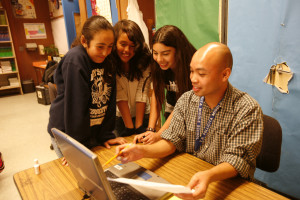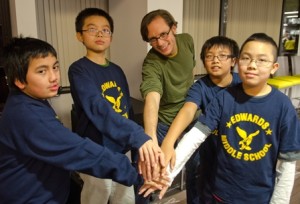How to Lengthen the School Day Without Overworking Teachers
We are always happy to see a longer school day featured in the news, such as in today's piece by Scot Lehigh. But too often these articles don’t tell the full story. Lehigh describes Expanded Learning Time in terms of three basic models, each of which are based on different ways of paying teachers for the extra time. However, Lehigh doesn’t consider a fourth model – partnerships between schools and non-profit organizations, including Citizen Schools, with a proven track record of improving student outcomes without overworking teachers.
 We agree with Lehigh’s recommendation to focus Expanded Learning Time efforts on low-income students who would most benefit from the added time. There's another way to focus attention strategically: concentrate on middle school. Research shows that middle school is a critical point in education, when students who show early warning signs of dropping out are most likely to become unengaged. By targeting expanded learning efforts in low-income middle schools, districts can make the most impact.
We agree with Lehigh’s recommendation to focus Expanded Learning Time efforts on low-income students who would most benefit from the added time. There's another way to focus attention strategically: concentrate on middle school. Research shows that middle school is a critical point in education, when students who show early warning signs of dropping out are most likely to become unengaged. By targeting expanded learning efforts in low-income middle schools, districts can make the most impact.
While Expanded Learning Time partnerships still require an investment from the district, schools are able to build capacity and make gains without spreading existing teachers too thin. For example, Citizen Schools mobilizes AmeriCorps members as Teaching Fellows, whose serve two years for a stipend funded by the federal Corporation for National & Community Service. They support teachers during the day, allowing time for collaboration and planning. In the afternoon hours, Teaching Fellows lead classes in math and ELA, focusing on homework and common core standards. They also engage with parents and families intensively (and bilingually), something that schools often lack the capacity to do.
Schools that partner with Citizen Schools, like the Orchard Gardens K-8 School and Edwards Middle School in Boston, have seen significant success with this model. Students who participate in Citizen Schools gain 3.5-5 months of added learning per year, which is greater than or comparable to the highest achieving charter school networks. Students are also seeing long-term success such as a 12 percent point increase in graduation rate.
 Furthermore, partnering with organizations like Citizen Schools provides schools access to valuable resources such as support from local corporations. Citizen Schools engages the professional community around schools through financial investments as well as bringing volunteers from all types of careers into the classroom to work hands-on with students. This engagement boosts the school’s presence in the community and provides students with real-world experiences and the chance to build new skills.
Furthermore, partnering with organizations like Citizen Schools provides schools access to valuable resources such as support from local corporations. Citizen Schools engages the professional community around schools through financial investments as well as bringing volunteers from all types of careers into the classroom to work hands-on with students. This engagement boosts the school’s presence in the community and provides students with real-world experiences and the chance to build new skills.
The result of Expanded Learning Time partnerships is a longer school day that is rich with opportunities for students, and doesn’t place a burden on teachers. Students see significant gains in achievement while exploring college and careers, and schools are able to thrive without breaking the bank.
UPDATE: An earlier version of this post misspelled the surname of columnist Scot Lehigh.
